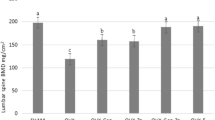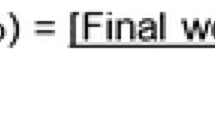Abstract:
The incidence of fractures and of osteoporosis differs between Oriental and Western Caucasian women. This may depend, at least in part, on nutritional factors, including dissimilarities in dietary intake of phytoestrogens. To investigate this possibility, 2-month-old female rats were ovariectomized (OVX) or sham-operated (SHAM), fed a casein-based diet, injected daily with subcutaneous genistein (GEN), the most abundant and best characterized phytoestrogen, or vehicle (Veh) and killed 21 days after surgery. As expected, ovariectomy resulted in loss of bone mineral density (BMD) and in uterine atrophy. However, administration of 5 mg GEN per gram body weight (b.w.) ameliorated the ovariectomy-induced loss of BMD (189 ± 2 mg/cm2 in OVX and 192 ± 2 in OVX with 5 mg GEN/g b.w. per day; p<0.05). One microgram GEN per gram body weight did not affect the BMD loss and the effect of the 5 mg and 25 mg GEN per gram body weight were statistically not different. A trend toward reduced uterine atrophy (21% reduction) was noted with the 25 mg GEN dose, but not with the 1 mg and 5 mg doses. A separate experiment with 2 x 2 factorial design was conducted to elucidate the mechanism by which GEN ameliorates ovariectomy-induced bone loss. In this experiment, histomorphometry demonstrated a dramatic reduction in trabecular bone volume after ovariectomy (7.6 ± 0.7% of total bone volume in SHAM-Veh vs 3.3 ± 0.2% in OVX-Veh; p<0.01) and less bone loss in OVX rats injected with 5 mg GEN per gram per day (3.3 ± 0.2% of total bone volume in OVX-Veh vs 5.2 ± 0.4% in OVX-GEN; p<0.01). Administration of GEN was associated with higher bone formation rate per tissue volume and with a trend toward a higher number of osteoblasts per bone perimeter. The parameters of bone resorption were not affected by GEN. The concentration of serum osteocalcin and the urinary excretion of deoxypyridinoline provided corroborating results. Since production of proinflammatory cytokines is intimately involved in the pathogenesis of postmenopausal osteoporosis, the effect of GEN on lipopolysaccharide-induced in vitro production of Tumor necrosis factor-alpha (TNFa) was tested in monocytic cells from the same four rat groups. Production of TNFa was markedly elevated in OVX-Veh as compared with the SHAM-Veh rats, but this was blocked by GEN in the OVX rats. This study shows that GEN reduces both trabecular and compact bone loss after ovariectomy and that this protective effect differs from that of estrogen, since it depends on stimulation of bone formation rather than on suppression of bone resorption. Lack of action of GEN on uterine atrophy supports the possibility that this GEN dose affects target tissues via non-estrogenic mechanisms. Modulation of cytokine production may be involved in the effect of GEN on bone.
Similar content being viewed by others
Author information
Authors and Affiliations
Additional information
Received: 27 June 1997 / Accepted: 27 October 1997
Rights and permissions
About this article
Cite this article
Fanti, P., Monier-Faugere, M., Geng, Z. et al. The Phytoestrogen Genistein Reduces Bone Loss in Short-Term Ovariectomized Rats . Osteoporos Int 8, 274–281 (1998). https://doi.org/10.1007/s001980050065
Issue Date:
DOI: https://doi.org/10.1007/s001980050065




